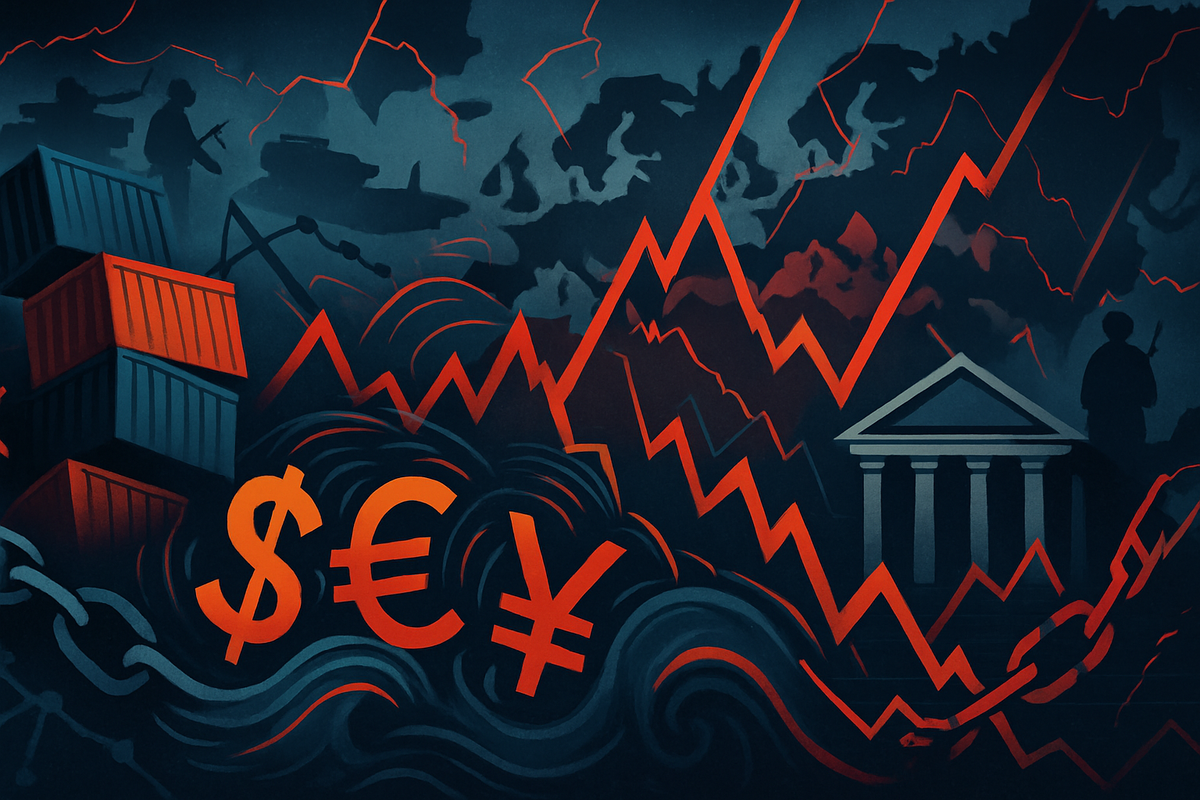
Global commodity markets are currently navigating a treacherous landscape marked by extreme volatility, a direct consequence of escalating geopolitical tensions, divergent monetary policy shifts, and persistent supply chain disruptions. As of October 23, 2025, an unpredictable confluence of these forces has unleashed sharp and often sudden price swings across a spectrum of essential resources, from crude oil and precious metals to vital agricultural products. This creates a challenging and uncertain environment for businesses, investors, and consumers worldwide, with immediate implications for inflation, economic stability, and global trade flows. The interplay of these factors suggests that market participants should brace for a sustained period of unpredictability and rapid adaptation.
The current state of affairs is characterized by a "war premium" on critical resources, particularly energy, fueled by ongoing conflicts and trade disputes. Simultaneously, central banks are walking a tightrope, attempting to curb inflation without stifling economic growth, leading to varied approaches that directly influence currency valuations and investment flows into commodities. Adding to this complexity, global supply chains remain fragile, susceptible to new trade barriers, logistical bottlenecks, and climate-related events, ensuring that the cost and availability of raw materials remain a significant concern for industries globally.
A Perfect Storm: Unpacking the Drivers of Commodity Market Mayhem
The current commodity market volatility is not a singular event but rather the culmination of several powerful, interconnected forces. Geopolitical instability remains a paramount driver, with ongoing conflicts and trade disputes directly impacting supply and demand dynamics. In the Middle East, persistent tensions, particularly the Israel-Iran conflict, continue to elevate crude oil prices due to concerns over supply disruptions, especially concerning critical chokepoints like the Strait of Hormuz. While a recent ceasefire in Gaza offered momentary respite, underlying animosities persist, contributing to fluctuating market expectations. The enduring Russia-Ukraine conflict also continues to ripple through global markets, most recently evidenced by new U.S. sanctions imposed on October 23, 2025, targeting key Russian state-owned oil entities, Rosneft PJSC and Lukoil PJSC. These sanctions caused crude oil futures to surge significantly, reigniting inflation anxieties and complicating monetary policy decisions globally. Additionally, escalating trade tensions between the United States and China are causing significant global market turmoil. President Trump's threats of "massive" tariffs, including a proposed 100% tariff on Chinese imports starting November 1, and China's implementation of new export controls on rare earth technologies, are disrupting commodity flows and raising global trade uncertainty. New U.S. port fees on Chinese vessels and retaliatory Chinese measures are further increasing shipping costs and altering established trade routes.
Monetary policy shifts by central banks globally are adding another layer of complexity. While many major central banks, including the European Central Bank (ECB) and the Bank of of England (BoE), have initiated or are planning rate cuts in 2025 to stimulate their economies, the U.S. Federal Reserve (Fed) stands as an outlier. The Fed is largely expected to keep its policy rates unchanged until early 2026 to firmly anchor inflation expectations, despite a dovish pivot aimed at a softening labor market. This divergence in monetary policy significantly impacts currency strengths, with a stronger U.S. dollar, potentially resulting from the Fed maintaining higher rates, creating headwinds for dollar-denominated commodities. Conversely, rate-cutting cycles generally benefit precious metals like gold by reducing the opportunity cost of holding non-yielding assets, contributing to gold's surge to record highs above $4,000 per ounce. However, this surge has not been without its own volatility, as evidenced by a "flash crash" on October 21, 2025, which saw gold plummet over 5% due to profit-taking and technical factors after being overbought. Silver has also seen a significant rally, propelled by physical market dynamics, industrial demand for green energy, and its traditional role as an inflation hedge.
Finally, global supply chains remain under considerable strain, with disruptions stemming from various sources. Escalating trade barriers and strategic competition for resources, especially in the mining and metals sector, are compelling a global shift from cost-efficiency to supply chain resilience. Maritime trade and logistics are particularly affected, with volatile freight rates, disruptions in key trading routes such as the Red Sea and the Strait of Hormuz, and persistent port congestion severely impacting global maritime trade. Global maritime trade growth is projected to stall in 2025, with volumes expected to rise by only 0.5%, a sharp decline from 2.2% in 2024, due to heightened uncertainty and increased costs. Rerouting vessels due to geopolitical tensions has increased shipping distances and operational costs. Domestically, a U.S. government shutdown in October 2025 has created a blackout of vital agricultural data during the peak harvest season, leaving traders "flying blind" and exacerbating speculation and volatility in agricultural markets. Furthermore, ongoing logistics challenges and shortages of shipping containers are tightening supplies in key consuming regions, significantly impacting commodity prices like coffee, which has reached an 11-year high due to adverse weather and demand increases. Cocoa production faces its worst supply shortage in 40 years due to aging trees, disease, pests, and unfavorable weather conditions, leading to soaring prices.
Winners and Losers: Corporate Fortunes in a Volatile Market
The current climate of commodity market volatility presents a mixed bag for public companies, creating both significant opportunities for some and considerable headwinds for others. Companies heavily invested in the energy sector, particularly those with diversified production capabilities and minimal exposure to geopolitical hotspots, stand to potentially benefit from elevated crude oil and natural gas prices. For instance, large integrated energy companies like ExxonMobil (NYSE: XOM) or Chevron (NYSE: CVX), with robust U.S. shale operations, could see increased revenues, although they must also contend with the broader economic implications of higher energy costs. Similarly, defense contractors such as Lockheed Martin (NYSE: LMT) or Raytheon Technologies (NYSE: RTX) may see sustained demand for their products and services as geopolitical tensions remain high, leading to increased defense spending globally. Logistics and shipping companies that can adapt quickly to rerouted trade routes and leverage alternative transport methods might also find opportunities, albeit with higher operational costs. Gold mining companies like Barrick Gold (NYSE: GOLD) or Newmont (NYSE: NEM) could experience a boost in profitability from record-high gold prices, though they too must contend with the inherent volatility of precious metals and rising input costs for their operations.
Conversely, a vast array of companies face significant challenges. Manufacturers across various sectors are particularly vulnerable, especially those reliant on stable and predictable commodity prices for their inputs. For example, automotive manufacturers like General Motors (NYSE: GM) or Toyota Motor Corporation (NYSE: TM) will grapple with higher costs for steel, aluminum, and other raw materials, which can erode profit margins or force price increases that deter consumers. Consumer goods companies, especially food processors and retailers, will likely face increased costs for agricultural commodities like wheat, coffee, and cocoa. This pressure could impact companies such as Nestlé S.A. (SWX: NESN) or Kraft Heinz (NASDAQ: KHC), potentially leading to higher retail prices for consumers or reduced profitability. Companies with extensive and complex global supply chains, particularly those heavily reliant on single-source suppliers or operating in politically unstable regions, are at high risk of disruptions and sudden price spikes. This includes many electronics manufacturers and apparel brands. Airlines, such as Delta Air Lines (NYSE: DAL) or United Airlines Holdings (NASDAQ: UAL), will face significantly higher fuel costs, directly impacting their operational expenses and potentially leading to increased ticket prices or reduced flight schedules. Businesses heavily reliant on maritime trade, especially those shipping through the Red Sea or Strait of Hormuz, will incur increased freight rates and longer transit times, impacting their inventory management and overall cost structure.
Wider Significance: Reshaping Global Commerce and Policy
The ongoing turbulence in commodity markets is not merely a short-term blip; it represents a significant inflection point with wider implications for global industry trends, regulatory frameworks, and economic policy. This era of heightened volatility is accelerating a broader industry trend towards deglobalization or, more accurately, regionalization and diversification of supply chains. Companies are increasingly prioritizing resilience over pure cost-efficiency, leading to investments in reshoring, nearshoring, and the development of multiple sourcing strategies to mitigate future disruptions. This shift is profoundly impacting global trade patterns, potentially leading to a fragmentation of economic blocs and a re-evaluation of international trade agreements. Furthermore, the push for energy transition is gaining renewed urgency, as the instability in traditional fossil fuel markets underscores the strategic imperative of diversifying energy sources. This could accelerate investment in renewable energy infrastructure and technologies, benefiting companies in the green energy sector while posing long-term challenges for traditional fossil fuel producers.
The ripple effects extend far beyond immediate market prices. Higher commodity costs feed directly into inflation, impacting consumer purchasing power and putting pressure on central banks to maintain tighter monetary policies, even at the risk of slower economic growth. This creates a challenging environment for policymakers attempting to balance price stability with employment targets. Governments are increasingly considering regulatory or policy implications, such as the strategic stockpiling of critical resources, like oil or rare earths, to buffer against supply shocks. Discussions around new trade agreements that prioritize supply chain security over sheer volume are also likely to intensify. Historically, periods of intense commodity volatility, such as the oil shocks of the 1970s or the commodity supercycle of the early 2000s, have often reshaped geopolitical alliances and economic policies. The current situation, with its multifaceted drivers, bears comparison to these periods, suggesting that the long-term consequences could be equally profound, potentially leading to a restructuring of global economic power and a redefinition of national security interests around resource access.
What Comes Next: Navigating the New Normal
Looking ahead, the immediate future for global commodity markets points towards continued, if not intensified, volatility. In the short term (the next 3-6 months), geopolitical events are likely to remain the dominant factor, often overshadowing fundamental supply and demand dynamics. Any escalation in the Middle East, further U.S.-China trade disputes, or new developments in the Russia-Ukraine conflict could trigger rapid price swings across various commodities. Central bank communications, particularly from the U.S. Federal Reserve, will be closely scrutinized for any signals regarding interest rate paths, as these will directly influence currency markets and, by extension, dollar-denominated commodity prices. Companies will need to maintain agile supply chain management, with a strong emphasis on real-time data and contingency planning to adapt to sudden disruptions and price changes.
In the long term, several strategic pivots and adaptations will be required across industries and by governments. Businesses will increasingly focus on building resilient supply chains through diversification, localization, and vertical integration where feasible. This may involve significant capital investments but is deemed essential for long-term stability. The energy sector will likely see continued investment in both traditional and renewable sources, with a focus on energy independence and security. Market opportunities may emerge in technologies that enhance supply chain visibility and efficiency, as well as in alternative energy and resource extraction methods. However, significant challenges will persist, including managing persistent inflationary pressures, navigating complex trade policies, and adapting to the accelerating impacts of climate change on agricultural output. Potential scenarios range from a gradual stabilization as new supply chains mature and geopolitical tensions ease, to a more fragmented global economy characterized by regional trade blocs and ongoing resource competition.
A Turbulent Horizon: Investing in Resilience
In summary, the global commodity markets are currently caught in a turbulent storm, driven by a powerful confluence of geopolitical tensions, divergent monetary policies, and persistent supply chain disruptions. This has resulted in unprecedented volatility across energy, precious metals, and agricultural commodities, impacting everything from corporate profitability to consumer purchasing power. The immediate implications include elevated inflation, increased operational costs for businesses, and significant uncertainty for global trade. While some sectors and companies, particularly those involved in energy production or defense, may find opportunities, a broader range of industries, especially manufacturing and consumer goods, face considerable headwinds.
Moving forward, the market is expected to remain highly dynamic and unpredictable, with geopolitical developments often dictating short-term movements. Investors should prepare for a sustained period of price swings and should prioritize resilience and diversification in their portfolios. Key factors to watch in the coming months include the trajectory of the Israel-Iran conflict, the implementation and impact of new U.S.-China tariffs, further actions by major central banks (especially the U.S. Federal Reserve), and the ongoing health of global supply chains. Companies that can demonstrate adaptability, strategic foresight in supply chain management, and a commitment to energy diversification will be best positioned to weather this storm and potentially emerge stronger. This period underscores the interconnectedness of global economics and geopolitics, making a holistic understanding of these forces critical for all market participants.
This content is intended for informational purposes only and is not financial advice






